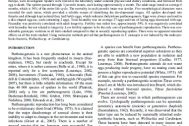Rok
2009Autoři
Stanislav Korenkoprof. Mgr. Stanislav Pekár, Ph.D.
prof. Mgr. Stano Pekár, Ph.D.
Druhy
Triaeris stenaspis Simon, 1892Obsah
Selected life-history traits of an oonopid spider, Triaeris stenaspis Simon, which has been introduced into greenhouses in Europe, were investigated. Spiders were reared in the laboratory under constant physical and dietary conditions, and followed from egg to death. The spiders passed through 3 juvenile instars, each lasting approximately a month. The adult stage lasted on average 6 months, which is 54% of the entire life cycle. The mortality in each juvenile instar was similar. Five morphological characters were recorded for each instar, which provided a reliable means of identifying the developmental stages. All spiders developed into females and although kept isolated they laid fertile eggs, which indicates thelytokous parthenogenesis. Eggs were always enclosed in a disc-shaped egg-sac, each containing 2 eggs. Total fecundity was on average 27 eggs and rate of laying eggs decreased with age. Fecundity was positively correlated with adult longevity. Fertility was rather low, approximately 59%. It was negatively correlated with fecundity but not related to longevity. Low fertility appears to be the only cost of parthenogenetic reproduction. There was considerable genotypic variation in all traits studied compared to that in sexually reproducing spiders. There were no apparent maternal effects on all the traits studied. Using molecular methods proved that parthenogenesis in Triaeris stenaspis is not induced by the endosymbiotic bacteria, Wolbachia sp. or Cardinium sp.



